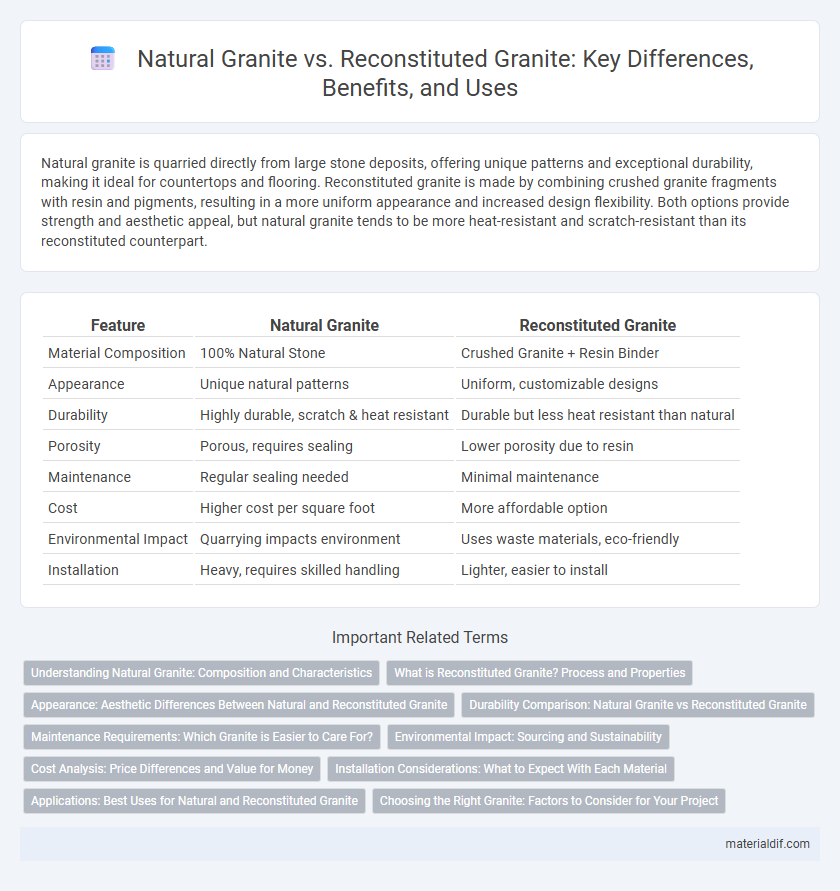Natural granite is quarried directly from large stone deposits, offering unique patterns and exceptional durability, making it ideal for countertops and flooring. Reconstituted granite is made by combining crushed granite fragments with resin and pigments, resulting in a more uniform appearance and increased design flexibility. Both options provide strength and aesthetic appeal, but natural granite tends to be more heat-resistant and scratch-resistant than its reconstituted counterpart.
Table of Comparison
| Feature | Natural Granite | Reconstituted Granite |
|---|---|---|
| Material Composition | 100% Natural Stone | Crushed Granite + Resin Binder |
| Appearance | Unique natural patterns | Uniform, customizable designs |
| Durability | Highly durable, scratch & heat resistant | Durable but less heat resistant than natural |
| Porosity | Porous, requires sealing | Lower porosity due to resin |
| Maintenance | Regular sealing needed | Minimal maintenance |
| Cost | Higher cost per square foot | More affordable option |
| Environmental Impact | Quarrying impacts environment | Uses waste materials, eco-friendly |
| Installation | Heavy, requires skilled handling | Lighter, easier to install |
Understanding Natural Granite: Composition and Characteristics
Natural granite is an igneous rock composed primarily of quartz, feldspar, and mica, which gives it unique durability and a distinct granular texture. Its formation through the slow crystallization of magma beneath the Earth's surface results in a dense, hard material resistant to scratches and heat. The natural variations in color and pattern make each slab of granite unique, enhancing its aesthetic appeal for countertops and architectural applications.
What is Reconstituted Granite? Process and Properties
Reconstituted granite is engineered by combining crushed natural granite fragments with resin and pigments, molded into slabs that mimic the appearance of natural granite. The process involves precise grinding, blending, and curing to create a durable, non-porous material with consistent color and pattern, making it resistant to stains and scratches. Its enhanced uniformity and lower maintenance requirements distinguish it from natural granite, while maintaining similar aesthetic qualities.
Appearance: Aesthetic Differences Between Natural and Reconstituted Granite
Natural granite exhibits unique and intricate patterns formed by geological processes, offering a wide range of colors and veining that make each slab one-of-a-kind. Reconstituted granite, composed of crushed natural granite mixed with resins and pigments, aims to replicate these patterns but often displays a more uniform and consistent appearance. The subtle variations and natural imperfections in natural granite provide a depth and authenticity that reconstituted granite typically lacks.
Durability Comparison: Natural Granite vs Reconstituted Granite
Natural granite boasts superior durability due to its dense crystalline structure, resisting scratches, heat, and weathering over extended periods. Reconstituted granite, composed of crushed natural granite bound with resins, offers decent durability but is comparatively more susceptible to chipping and discoloration from prolonged exposure to UV rays and heavy impact. Choosing natural granite ensures long-term resilience in high-traffic or outdoor applications, while reconstituted granite suits indoor settings with moderate usage.
Maintenance Requirements: Which Granite is Easier to Care For?
Natural granite requires regular sealing to protect against stains and moisture, making maintenance more demanding over time. Reconstituted granite, composed of crushed stone and resins, offers a non-porous surface that resists staining and eliminates the need for frequent sealing. Its durability and low absorption rate make reconstituted granite easier to care for in both kitchen countertops and bathroom installations.
Environmental Impact: Sourcing and Sustainability
Natural granite is quarried directly from the earth, often resulting in significant landscape disruption, habitat loss, and high energy consumption during extraction and transportation. Reconstituted granite, made from crushed natural stone mixed with resins and pigments, utilizes waste materials and reduces the need for extensive quarrying, leading to lower environmental degradation and improved resource sustainability. Choosing reconstituted granite supports circular economy principles by minimizing raw material extraction and promoting recycling within the stone industry.
Cost Analysis: Price Differences and Value for Money
Natural granite typically costs between $50 to $200 per square foot, reflecting its unique patterns and durability sourced directly from quarries. Reconstituted granite, also known as engineered stone, ranges from $40 to $120 per square foot, offering a more affordable option with consistent appearance and reduced waste. Considering long-term value, natural granite provides higher resale appeal due to its exclusivity, while reconstituted granite delivers cost-efficiency and easier maintenance for budget-conscious homeowners.
Installation Considerations: What to Expect With Each Material
Natural granite requires precise measurement and skilled handling due to its unique, irregular patterns and weight, often necessitating professional installation to prevent cracking and ensure proper fit. Reconstituted granite, composed of crushed stone and resin, offers more uniformity and lighter weight, making it easier to cut and install with standard tools, reducing labor time and installation costs. Both materials demand sealed surfaces to protect against staining, but natural granite's porous nature typically requires more frequent resealing compared to the more resilient reconstituted alternative.
Applications: Best Uses for Natural and Reconstituted Granite
Natural granite is ideal for outdoor applications such as patios, walkways, and exterior cladding due to its durability and resistance to weathering. Reconstituted granite excels in interior surfaces like countertops, flooring, and decorative wall panels, offering a consistent appearance and ease of customization. Both materials provide excellent hardness and aesthetic appeal, but natural granite is preferred for high-traffic or exposed environments while reconstituted granite suits controlled indoor settings.
Choosing the Right Granite: Factors to Consider for Your Project
Natural granite offers unparalleled durability and unique veining patterns, making it ideal for projects requiring authentic stone aesthetics and long-lasting performance. Reconstituted granite, composed of crushed stone combined with resin and pigments, provides consistent color options and cost-effectiveness suitable for budget-conscious renovations. When choosing between natural and reconstituted granite, consider factors like project scale, desired appearance, budget constraints, and maintenance requirements to ensure the selected material aligns with your design goals and functional needs.
Natural Granite vs Reconstituted Granite Infographic

 materialdif.com
materialdif.com